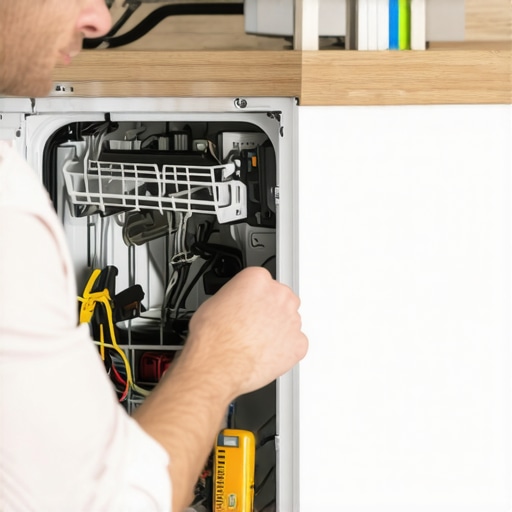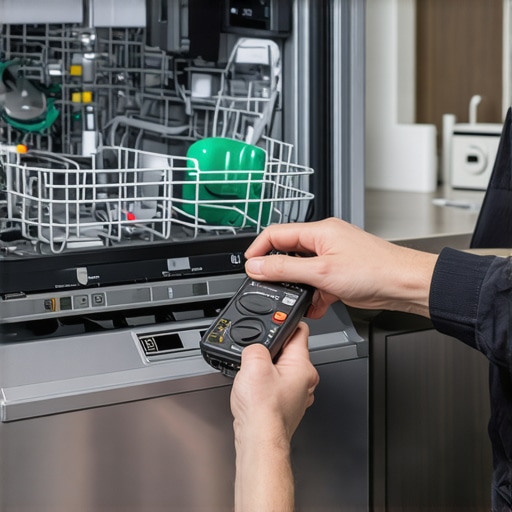My Journey with Dishwasher Parts: From Frustration to Fixes
Not long ago, I found myself staring at a dishwasher that suddenly refused to run. As someone who loves DIY solutions, I dove into understanding the essential parts involved in repairs and diagnostics. That experience turned into a rewarding journey, giving me the confidence to troubleshoot and fix common issues without always calling in a pro.
Understanding the Heart of Your Dishwasher: Essential Parts to Know
When my dishwasher started leaking, I realized I needed to identify the culprit. I learned that key components like the water inlet valve, drain pump, and float switch are vital for proper operation. Knowing these parts helped me diagnose problems quickly. For example, a faulty inlet valve can cause inadequate water supply, which I encountered firsthand. For more detailed insights, I recommend checking out this comprehensive guide on appliance diagnostics.
DIY Repairs: My Personal Tips for Troubleshooting
In my experience, the first step is always to unplug the appliance and inspect visible parts. I often found that cleaning or replacing a worn-out part, like the door latch or spray arm, made a significant difference. Sometimes, issues are caused by simple clogs or debris blocking water flow. Using diagnostic procedures similar to those found in professional manuals has saved me time and money. I also discovered that a multimeter is invaluable for testing electrical components, ensuring safety and accuracy.
Why Knowing Your Parts Matters More Than You Think
Understanding your dishwasher’s parts transforms troubleshooting from guesswork into a methodical process. It’s empowering to replace a faulty pump or thermostat instead of waiting for a technician. Plus, it extends the lifespan of the appliance and saves money. Remember, always consult your user manual or trusted repair guides—like this helpful resource—to ensure proper procedures.
How can I identify the root cause of dishwasher problems effectively?
My approach is to observe the symptoms carefully—whether it’s not draining, not filling, or not cleaning—and then check the relevant parts step by step. Reading reviews and tutorials from trusted sources can shed light on common failure points. Sometimes, just resetting the breaker or cleaning the filters can solve issues that seem complex at first.
If you’re interested in exploring more about troubleshooting and repairing dishwashers, I highly recommend visiting this detailed troubleshooting guide. Sharing experiences and tips with others has been incredibly helpful in my DIY repair journey, and I invite you to comment below with your own stories or questions.
Deciphering the Diagnostic Puzzle: What Do Your Dishwasher Symptoms Really Mean?
When faced with a dishwasher that isn’t performing as expected, it’s tempting to jump straight into replacing parts. However, understanding the subtle clues your appliance offers can save you time and money. For instance, if your dishwasher isn’t draining, it could be a clogged drain hose, a faulty drain pump, or even a problematic float switch. Recognizing these symptoms and correlating them with specific parts is crucial for effective troubleshooting. For a detailed breakdown of these components, visit this comprehensive parts guide.
Advanced Troubleshooting Techniques: Going Beyond the Basics
While inspecting visible parts is essential, sometimes issues require a more nuanced approach. Using diagnostic tools like multimeters to test electrical continuity or voltage can reveal hidden faults. For example, testing the wiring to the control board can uncover issues that are not apparent physically. Additionally, examining the operational cycle—listening for abnormal noises or watching for irregular water flow—can provide insights into mechanical problems. These techniques elevate your repair skills from basic to expert level, enabling more precise fixes.
How Can I Prevent Future Dishwasher Failures?
Prevention begins with regular maintenance. Cleaning filters and spray arms, checking for debris in the drain, and inspecting door seals can significantly reduce breakdowns. Also, being mindful of what you put into your dishwasher—avoiding overly greasy or fibrous foods—helps prevent clogs and wear. Implementing routine checks and cleaning schedules, perhaps monthly, can extend the lifespan of key parts like the inlet valve and pump. For further guidance on preventive maintenance, explore this resource.
What are the *hidden* complexities of diagnosing dishwasher problems that even seasoned DIYers might overlook?
A common oversight is neglecting the electrical control system. Modern dishwashers rely heavily on electronic control boards that can develop faults unseen without proper testing. Micro-cracks or burnt-out relays may cause intermittent failures, which are tricky to diagnose without specialized equipment. Additionally, issues like misaligned or damaged door latches can prevent the cycle from starting, despite everything else functioning correctly. As an expert, I recommend consulting detailed diagnostic procedures and leveraging trusted repair guides like this troubleshooting resource to uncover such hidden faults.
If you’re eager to deepen your repair skills, I encourage you to share your experiences or ask questions below. For those looking to expand their knowledge, exploring related topics like oven repair diagnostics can also be incredibly valuable, especially since many appliances share similar diagnostic principles.

Unlocking the Hidden Layers of Dishwasher Troubleshooting
Over time, I’ve come to realize that diagnosing dishwasher problems is much like peeling back the layers of an onion—each symptom unravels a deeper story beneath the surface. For instance, when a dishwasher refuses to start, it’s tempting to assume a simple power issue, but often, the root cause lies in a more subtle component like the control board or even a misaligned latch. This layered understanding transforms a frustrating experience into a rewarding puzzle, where patience and curiosity lead to effective fixes.
The Subtle Art of Reading Symptoms Beyond the Obvious
One lesson I’ve learned is that symptoms rarely exist in isolation. A dishwasher that stops mid-cycle might be more than just a faulty motor; it could be an electrical fault in the control system or a sensor malfunction. Sometimes, listening carefully to unusual noises or observing irregular water flow patterns offers clues that aren’t immediately obvious. These nuances, which I’ve encountered during countless repair attempts, underscore the importance of a holistic approach. To deepen your diagnostics, I recommend exploring this comprehensive troubleshooting guide.
Advanced Techniques for Diagnosing Complex Issues
Beyond visual inspection, employing diagnostic tools like multimeters and circuit testers elevates your repair skills significantly. I vividly remember testing the wiring to the control board after suspecting an electrical fault; the process revealed a tiny, burnt relay that was causing intermittent failures. Such precision testing requires patience and a good understanding of electrical principles, but it’s incredibly satisfying when you pinpoint the exact issue. For those interested in honing these skills, exploring detailed diagnostic procedures, like those found at this resource, can be a game-changer.

Why Hidden Faults Can Fool Even Experienced DIYers
Sometimes, the most elusive problems are hidden within the electronic control system. Micro-cracks on the control board or faulty relays can cause sporadic failures that seem inexplicable. I’ve learned to distrust appearances and always perform electrical testing before replacing major components. Additionally, door latch misalignments or damaged sensors can silently sabotage the cycle, even when everything else appears functional. Recognizing these hidden faults is crucial, and consulting detailed diagnostic guides ensures you don’t overlook these subtle but critical issues.
Inviting You to Share Your Diagnostic Stories and Insights
If your repair journey has led you to uncover unique faults or innovative troubleshooting techniques, I invite you to share your experiences below. Learning from each other’s stories enriches our collective knowledge and makes tackling these appliances less daunting. For further exploration, don’t miss out on related content like this insightful guide on oven diagnostics. Remember, the path to mastering dishwasher repairs is a continuous journey filled with discovery and learning.
Decoding the Intricacies of Electronic Control Systems in Dishwashers
One of the most challenging aspects of troubleshooting modern dishwashers lies in their sophisticated electronic control systems. As I delved deeper into diagnosing complex issues, I discovered that micro-cracks or burnt relays on control boards often manifest as intermittent failures, elusive to visual inspection alone. Utilizing specialized diagnostic tools, like circuit testers and advanced multimeters, became essential in my toolkit. For instance, I once identified a tiny relay failure that caused sporadic cycle interruptions—an issue that traditional tests would have missed. This experience underscored the importance of understanding the electronic architecture of your appliance, which can be explored further in this detailed troubleshooting guide.
Recognizing the Subtle Signs That Signal Underlying Control Failures
In my practice, I’ve learned that symptoms like irregular cycle timing, inconsistent water temperatures, or sudden cycle halts often point to hidden control faults. For example, a dishwasher that unexpectedly aborts mid-cycle despite no visible mechanical issues might have a malfunctioning relay or a micro-crack in the control board. Listening for unusual electronic noises during operation or observing erratic display messages can provide crucial clues. These nuanced symptoms require a keen eye and a methodical approach, which I refined through hands-on experience and continuous learning. For an in-depth exploration of diagnosing such electronic faults, I recommend reviewing this comprehensive resource.
How Do I Safely Test and Validate Electronic Components?
Testing electronic components safely and accurately is paramount. I always start by unplugging the appliance and disconnecting the control unit for testing. Using a high-quality multimeter set to measure resistance or voltage, I meticulously check relays, capacitors, and resistors for anomalies. For example, a relay that fails to close or open properly can cause cycle execution issues. When dealing with sensitive circuit boards, I also employ magnification tools to inspect solder joints and micro-cracks. This meticulous process not only prevents accidental damage but also ensures precise diagnosis. To deepen your understanding, exploring this authoritative guide on appliance diagnostics can be invaluable.
Engaging with the Community: Sharing and Learning from Complex Diagnoses
Throughout my journey, I’ve found that sharing detailed experiences with fellow DIY enthusiasts and professional technicians enriches my knowledge base. Whether it’s diagnosing a sporadically failing control board or tracing obscure electrical faults, exchanging insights often unveils innovative solutions. I encourage you to document your diagnostic process and seek feedback from experienced practitioners. Engaging with online forums or repair communities dedicated to appliance troubleshooting can accelerate your learning curve. For comprehensive tips on troubleshooting complex issues, don’t miss this expert guide. Let’s continue this conversation—share your experiences or ask questions below to foster collective expertise.
Things I Wish I Knew Earlier (or You Might Find Surprising)
The Hidden World of Electrical Control Systems
One thing that caught me off guard was how much the control board influences a dishwasher’s performance. I used to think mechanical parts were the main culprits, but I learned that tiny micro-cracks or burnt relays on the control board can cause intermittent failures. This realization made me more cautious and thorough in diagnostics, especially when visual clues aren’t enough. Sharing this insight has saved me hours of guesswork and unnecessary part replacements.
Symptoms Are Often Deceptive
Early on, I believed that a dishwasher not draining was always a simple clog. Turns out, it can also be an electrical issue or a faulty drain pump that hides behind the scenes. Paying close attention to subtle symptoms—like unusual noises or irregular water flow—can reveal underlying problems before they escalate. This approach has helped me diagnose issues more accurately and efficiently.
Beware of Hidden Electrical Faults
One of the trickiest problems I faced involved sporadic cycle halts that no mechanical part seemed to explain. After testing with a multimeter, I discovered a tiny relay failure on the control board that was causing the cycle to abort unexpectedly. It’s a reminder that electrical testing is essential, and sometimes the most elusive faults are within the electronic brains of the appliance.
Preventative Maintenance Is Your Best Friend
Regularly cleaning filters, inspecting door seals, and avoiding overly fibrous foods can significantly prolong your dishwasher’s lifespan. I’ve found that simple routine checks save money and reduce breakdowns, making DIY repairs less daunting. Exploring detailed maintenance tips at this helpful resource has been invaluable for me.
Patience and Curiosity Are Key
Finally, I’ve realized that troubleshooting is as much about patience as it is about technical skill. Each problem is a puzzle, and every step I take uncovers new clues. Embracing the learning process makes repairs more rewarding and less stressful. If you’re eager to deepen your understanding, I recommend exploring this comprehensive guide.
Resources I’ve Come to Trust Over Time
ApplianceBargainz’s Troubleshooting Guides
This site offers detailed, step-by-step diagnostics and repair tips that have become my go-to reference. The explanations are clear, practical, and backed by real-world experience, making complex issues approachable.
Manufacturer Manuals & Official Documentation
Nothing beats the original manuals for understanding your specific dishwasher model. They provide essential diagrams and troubleshooting steps that aren’t always available elsewhere. I always keep a digital copy handy.
Online Repair Communities & Forums
Engaging with fellow DIY enthusiasts and professionals in forums can provide fresh perspectives and solutions. Sharing stories and asking questions accelerates learning and often reveals clever hacks I wouldn’t have discovered alone.
Trusted YouTube Repair Channels
Visual guides from experienced technicians help me see exactly how parts are replaced or tested. Watching repair videos demystifies complex procedures and boosts my confidence.
Parting Thoughts from My Perspective
Understanding your dishwasher’s parts and how they interact has transformed my approach from frustration to empowerment. DIY repair isn’t just about saving money; it’s about gaining confidence and a deeper appreciation for these complex appliances. The key is patience, curiosity, and utilizing trustworthy resources like this guide to navigate the troubleshooting maze. If this resonated with you, I’d love to hear your stories or questions. Sharing our experiences makes the journey more rewarding for everyone.

